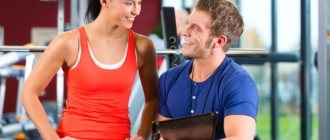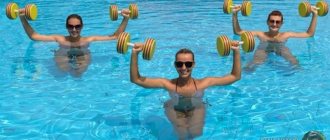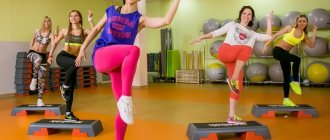General recommendations for water training
If you've never done water aerobics, find a professional trainer to teach you the technique. Start studying on your own only after his approval.
Water aerobics classes are conducted in pools on 1-2 separate paths at a depth of up to 1.5 meters. Thanks to this, people who are overweight, cannot swim, or are pregnant can train effectively.
There are also groups that train at a depth of 2 meters - join them when the previous load seems easy.
For exercises, the trainer will give you equipment:
- aqua gloves;
- aquabelt;
- burdens;
- noodles;
- rubber poles, turntables, sticks;
- flippers;
- water dumbbells and foam barbells.
You buy a swimsuit and a rubber cap and bring it yourself. If you are allergic to pool disinfectants, make sure you have swimming goggles.
Eat at least 2 hours before training. Before class, take a cooling shower to prepare your body for cold water. Enter the pool gradually; jumping from the side and sudden dives will lead to heart pain.
There are no complete contraindications to water aerobics. The exercises can be performed by people prone to seizures, those who have had heart attacks, those with osteochondrosis and pensioners, but always under the supervision of a trainer.
Water aerobics is a cardio exercise, so you need to monitor your heart rate throughout the workout.
Exercises for weight loss
In order to get a visible effect from exercise in the form of weight loss in the hips, abdomen and arms, follow the following conditions:
- Exercise regularly, at least 2 times a week for 40 minutes;
- Keep the pace throughout the entire workout, monitor your heart rate, the effect will occur when your heart rate is about 70-80% of the maximum;
- The water temperature in the pool should be in the range of 25-30 degrees Celsius;
- Keep your fingers closed to create better resistance to the water.
Please note that exercise in the pool, especially when it comes to the process of losing weight, becomes effective only if it is carried out at an intense pace. Focus on your pulse. Keep it in the “fat burning” zone throughout your workout. How to calculate the heart rate in this zone? Calculate using the formula: Pulse = 220 - (your age) * 0.7
Do basic exercises for weight loss:
- We do a “kick”. Stand up straight, move your left leg forward, direct your body weight onto it, while bending your leg slightly. Overcoming the resistance of the water, we throw our right leg forward, toe toward ourselves, and vigorously move our arms back behind our back. Then return to the starting position;
- Twist diagonally. To lose weight in the abdominal area, we do an exercise for the oblique muscles, to do this we raise the leg to the level of the belt, and move the opposite arm diagonally down. You have done this task correctly if your elbow touches your knee. Then return to the starting position and do the same with the other leg;
- We are working on the upper part of the body. We stretch our arms to the sides, put our hands behind our backs, as if we were doing a clap, while we tighten the shoulder blades as much as possible, do a light jump, return our hands to the front of the body and do the same clap;
- Let's do the hands. We bring our fingers together tightly, bend our arms at the elbow to an angle of 90 degrees and sharply straighten them. At the same time, we actively overcome the resistance of water.
All exercises are effective if done 3 sets 20 times. While resting between sets, you can do a few light jumps.
A set of water aerobics exercises for beginners
Let's consider classes for those who are just starting training:
- Underwater running and walking . Get into the pool up to your waist, walk in place for a couple of minutes, lift your hips high. Gradually increase your pace until you can run.
- Jumps . While in waist-deep water, straighten your back. Start jumping first on two legs, then on one. Agree on the number of jumps with the trainer. This exercise helps correct your posture.
- Jumping . Stand on the part of the path where the water is up to your chest, with your feet wider than shoulder-width apart. Jump high while bringing your legs together. Spread them when you stand on the floor of the pool. Perform up to 15 times.
- Scissors . Stand in water up to your neck, straighten your arms horizontally, palms forward. Bring your arms together in front of your chest to create a reverse stroke. Perform up to 20 times. The workout works the muscles of the upper back.
- Knee raises . With your hands clasped, stand up straight. Bring your legs bent at the knees to your chest one by one. To work your abs, pull your legs up at the same time. Do it 20 times.
At the end of the workout, practice with the ball in a group. Throwing and catching help strengthen the musculoskeletal system and relax after exercise.
Hull operation
Balance on the chest
Sliding in the pool
Push off from the side and slide with your arms extended forward and your head between them. Ideally, slide underwater for as long as possible before surfacing. Next, slide until you come to a complete stop.
Push from the side and slide
Do 5-10 reps.
Thanks to this, we learn to feel the balance of the body , including feeling whether it is leaning forward, backward or sideways, and we also develop muscle mass in static conditions to maintain a horizontal position in the water.
Sidestroke
Swim the pool on your side using your legs , while one arm (supporting, lower) should be extended forward and the other pressed to the body. When you swim back, change sides.
You can also do a change right during the swim - for example, every six kicks.
Another option for completing this task is shown in this video:
Slip
Skater
Imagine a speed skater who glides across the ice and makes his glide even faster by pushing with his foot .
Try to do the same in water, only our tools in this case will be our hands.
Modify your normal swimming technique (in which you constantly change hands) as follows: after completing a stroke with one hand, do not immediately move the other, but slide a little and only then make a stroke with the other hand. At this moment, imagine yourself as the same speed skater who is gliding and with the movement of his limb only speeds up his glide.
This technique makes it very good to feel that the basic principle of swimming is gliding, and our limbs should only accelerate it.
Five strokes plus a glide
We alternate strokes and side slides, as shown in this video:
Body rotation
Ten by ten
We swim with one hand pressed to the body and the other extended forward, head on the side, mouth above the water. We make 10 kicks, then we make a stroke with our hand, we carry the second one and put it into the water (that is, we change them). Then, after 10 strokes, we repeat this operation again.
During these cycles, we focus on rotating the body .
10/10 with breathing
We do the same as in the previous task, only now we swim with our head in the water and add breathing.
Then we gradually reduce the number of strokes until we move on to the usual six-beat crawl.
For the abs and belly
Exercises in water perfectly strengthen the abdominal and abdominal muscles, help you lose weight and get in shape after childbirth. Do them like this:
- Holding the side, do the “bicycle” exercise 15 times forward and backward.
- Stand sideways to the ledge of the pool, place your hand on it, bring your legs together and pull them towards your chest. 10 reps on each side.
- With both hands, firmly grasp the side of the board while facing it. Keeping your back straight, lift your legs one by one 15 times to the level of the ledge.
- Go to a greater depth so that your feet do not touch the bottom, straighten up. Raise your legs 90 degrees 10 to 20 times.
- In the same starting position, do scissors as much as you can. Repeat in vertical and horizontal positions.
- Lean your hands on the side and take a step away from it, start doing the usual push-ups 10 times in one approach. To make it more challenging, do push-ups with only one arm or add clapping.
Be sure to swim between sets.
For legs
After warming up, do the following exercises:
- Horizontal scissors. Lie down on the water, grab the side with your hands, spread your legs as you inhale, and bring them together as you exhale. Do 20-30 times. This will help you strengthen your inner thigh muscles.
- Stretching. Lean against the wall of the pool, bend your knees. Straightening your right or left leg, stretch your body behind them. Perform the number of repetitions according to how you feel.
- Jumping . During the exercise, make sure to bring your legs forward as much as possible. When it becomes easy to do, jump on each leg alternately 15 times.
- Mahi . Stand on the bottom of the pool, extend your arms and place them on the water at chest level. Raise your legs 15 times, trying to touch them to the opposite palm.
Training for leg muscles in the pool is much safer than usual in the gym, since during it no injuries occur and the joints do not suffer.
For the buttocks
Water aerobics is a great helper for those who want to get rid of cellulite and pump up their gluteal muscles. You can achieve beautiful shapes like this:
- Take steps in the water for 20 minutes, raising your legs as high as possible.
- Take an upright position, tense your buttocks and bend your knees 10 times, trying to reach your hips with your feet.
- Walk quickly along paths with a depth of 1-1.5 meters for 10-20 minutes.
- Standing in water up to your chest, do boxing lunges with your hands and at the same time raise your bent legs 15 times.
- Stand sideways to the side, lean on one hand, then make high swings with the leg that is closest to the ledge of the pool. Repeat 10-15 times on each leg.
You can consolidate the results of your workout by simple swimming, which also helps strengthen the muscles of the buttocks.
Exercises for losing belly fat
Classic fitness presents many different exercises for the abdominal area. All of them help strengthen muscles and increase endurance. But, unfortunately, most of them have a fairly wide list of contraindications. Various twists and stress on the abdominal muscles, for example, are strictly prohibited for women during the recovery period after a cesarean section or for people after various surgical interventions.
A set of exercises developed by specialists for the pool can come to the rescue. Let's look at a few of the most effective ones.
Bike
To perform the exercise, you need to secure your hands to a special handrail or side of the pool. Bend your knees at a right angle, and exhale, begin movements that imitate riding a bicycle. First rotate them forward, then back, about 15-20 seconds on each side.
“Bicycle” helps strengthen the abdominal, back, and front thigh muscles.
Crunches
The crunch exercise effectively works the abdominal muscles, as well as the lower abdominal area, which usually causes the greatest discomfort in both women and men.
To do this you need:
- turn your back to the side of the pool, bend your arms at the elbows and rest them on the edge. In this case, the body should be immersed in water up to the chest;
- exhale, pull your legs to your chest, and inhale, lower them back.
Such approaches must be done at least 3, 20-30 repetitions for each.
Turns
This exercise is similar in technique to the previous one, but helps to work not only the rectus abdominis muscles, but also the obliques. This is done as follows:
- turn your back to the side of the pool, bend your arms at the elbows and rest them on the edge. In this case, the body should be immersed in water up to the chest;
- exhale, bend your knees, pull them to your chest and twist to the left, and inhale, lower them back. The body and chest should look forward, and the waist and hips should turn to the left or right side;
- repeat the exercise on each side 10-15 times.
It should be understood that accumulations of fat in the abdominal area are formed for various reasons. These may be the consequences of an unhealthy lifestyle, abuse of junk food or alcohol, symptoms of various diseases, and much more. It is important to establish the true factors behind the appearance of extra pounds, otherwise no exercise will help - the weight will return again and again, constantly increasing. Only specialists from a weight loss clinic who have a wide range of experience, a huge base of knowledge, tools and equipment can help with this.
For weight loss
Water resistance puts more strain on muscles and increases energy expenditure, which is the first condition for losing weight. Any workout in water significantly helps you lose weight, especially if you use special equipment.
A set of water aerobics exercises for weight loss usually includes the following exercises:
- "Scissors".
- "Bike".
- Swing your legs and arms.
- Walking and running in water.
- Squats.
Be sure to do a warm-up - simple swimming for a few minutes. Towards the end of the workout, perform the exercises less intensely; at the very end, be sure to lie down in the water to relax your muscles.
Results from water aerobics for weight loss will appear if you do 3-4 times a week for 40 minutes or more.
Watch a video of a water workout aimed at losing weight:
Benefits of exercising in water
Exercises in the pool benefit the body and are suitable for people of any age, even if they have any chronic diseases, for which exercise on exercise machines and group fitness training is prohibited. How are exercises in the pool more beneficial compared to fitness?
- Heart training. Exercise in water helps improve the functioning of the cardiovascular system. Due to aerobic exercise, tissues are saturated with oxygen, which results in increased blood circulation and cleansing of the walls of blood vessels.
- Protection from stress. There are studies that show that regular exercise in the pool and swimming help reduce stress levels and improve your mood. This can be explained quite simply: during training in water, there is an active release of endorphins, the so-called “hormones of joy.” Such training helps reduce muscle tension, reduce anxiety, and increase concentration.
- Muscle tone. Exercises in the pool have a gentle effect on the muscles, strengthening them. And, although the load is not felt as strongly as in the gym, the effect will be much better due to the constant overcoming of water resistance.
- Strengthening joints. Most types of fitness training are contraindicated for overweight people, as this can lead to injuries to the joints and spine. But exercises in the pool, on the contrary, improve the functioning of cartilage, tendons, and muscles.
There are several types of pool training. The choice of the right one depends on personal preferences, capabilities and the opinion of the doctor. Let's take a closer look at the main directions that help you lose weight.
With dumbbells
Exercises with rubber dumbbells are aquashaping. The most effective of them:
- Holding 1 kg dumbbells in each hand, walk in place for 2 minutes, raising your knees high. The hands must be mobile.
- Place your arms with dumbbells at your sides, then bring them together, while jumping so as to touch your chest. Repeat 15 times.
- Lean forward a little, alternately stretch one arm forward and the other back. Repeat 15 times.
- With your feet shoulder-width apart, press your hands with weights to your chest, sharply throw them forward and return them back as many times as you can.
When the exercises start to feel easy, choose dumbbells with more poundage.
Watch a video with a set of exercises in water with dumbbells:










